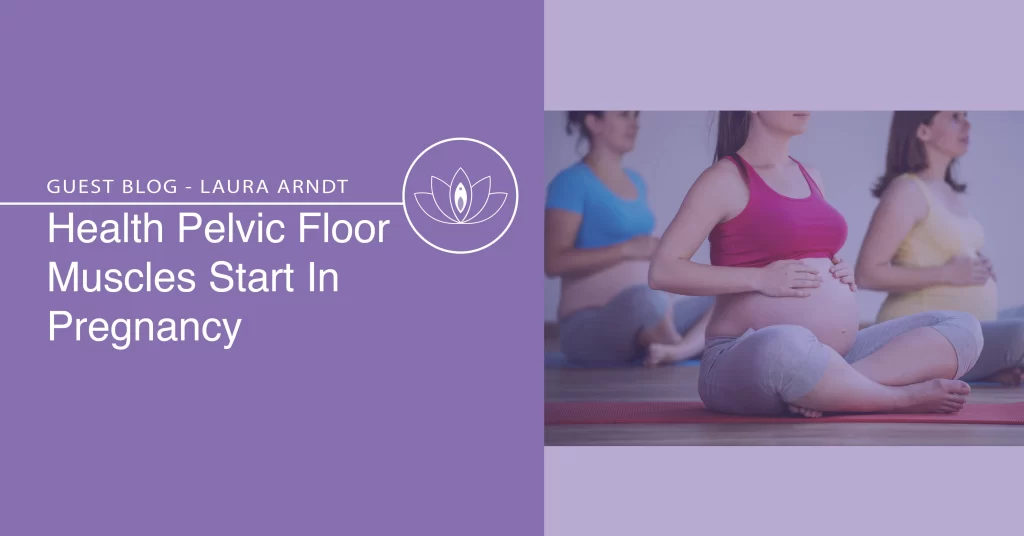Did you know that healthy pelvic floor muscles start in pregnancy? We are delighted to have Laura Arndt, CEO of the recently launched Matriarc App share this wonderful post on why you shouldn’t wait until after your delivery to focus on the health of your pelvic floor muscles.
What Is the Pelvic Floor and Why Is It Important?
Your pelvic floor is a group of muscles and tissue located at the base of your spine and supported by the muscles of the lower abdomen. And they have a very important job. Together, the pelvic floor muscles work to support your bladder, uterus, vagina, small bowel, and rectum. Yup, important job.
Pelvic floor dysfunction is commonly associated with childbirth. Many women will experience it in a minor way, at least (hello, sneeze pees!), but it isn’t uncommon to experience other side effects: pain during intercourse, urinary or fecal incontinence, prolapse of the bladder, uterus or colon (pelvic organ prolapse), pelvic pain and urinary tract infections.
Needless to say, Pelvic floor dysfunction can be embarrassing, at the least, and, at the most, expensive, time-consuming and very disruptive to your quality of life.
What Can You Do During Pregnancy and Postpartum to Maintain Healthy Pelvic Floor Muscles?
First, let’s acknowledge that many factors leading to pelvic floor dysfunction are outside of your control including: family history, chronic coughing, and how you deliver your baby. But, you can take steps during your pregnancy to protect your pelvic floor health.
Steps You Can Start Taking Today:
Maintain a healthy weight during pregnancy and return to a healthy BMI post pregnancy. A study from Yale Univerisity showed women who returned to a healthy BMI within one year post-delivery had reduced risk of Pelvic Organ Prolapse.
Don’t Smoke – Cigarette smoking can cause chronic coughing, leading to damage to the pelvic floor muscles.
Avoid exercises and activities that build too much abdominal pressure in the second and third trimesters. For example, heavy lifting, crunches, sit-ups and planks. Sitting straight up from a laying down position builds abdominal pressure and research shows that engaging your pelvic floor and transverse abdominals first, may reduce the distortion of your diastasis recti.
Get into healthy habits now – Especially with the foods you are eating – to nurture your body. During pregnancy and after baby, especially if you breastfeed, you will need more calories and fluid. But remember to be mindful of your intake and mix it up with a variety of fruit, vegetables, lean protein and whole grains to balance the nutrients your body needs. It can be tricky to ensure regular meals, so supplements and pre / post-natal vitamins can help round up nutritional gaps.
What Can You Do During Pregnancy and Postpartum to Maintain Healthy Pelvic Floor Muscles?
Once cleared for exercise, your stomach and pelvic floor muscles don’t self-heal. They will need extra attention in the first year postpartum. A few minutes a day goes a long way towards rebuilding the muscles most affected by pregnancy and delivery. Download the Matriarc app for easy, quick exercises to help restore your pelvic floor and core.
Your stomach and pelvic floor muscles don’t self-heal. They will need extra attention in the first year postpartum.
Pregnancy and childbirth put an enormous strain on your body. As with most things in pregnancy, some changes are not always within our control, but it helps to take some time to care for our own bodies at this moment too. Paying extra attention to your pelvic floor muscles early and being attentive to the points above will help you avoid pelvic floor dysfunction later.
Below is one simple, and safe, core strengthener to get you started with building healthy pelvic floor muscles:
Pelvic Tilt
Start in the supine position with your knees bent and your feet flat. Tilt your hips slowly towards your feet and then tilt your hips back, pressing your lower back into the mat.
If you are need a local specialist to help you get started, you can search our specialist directory.

